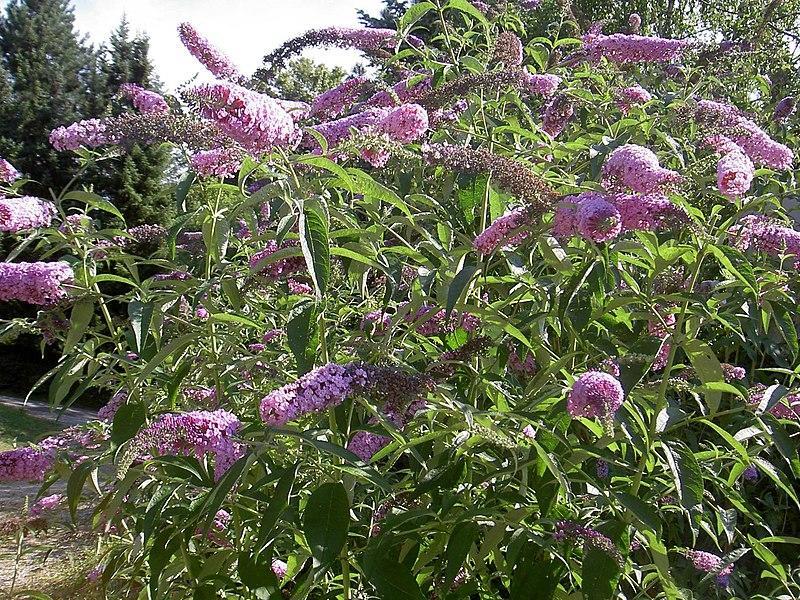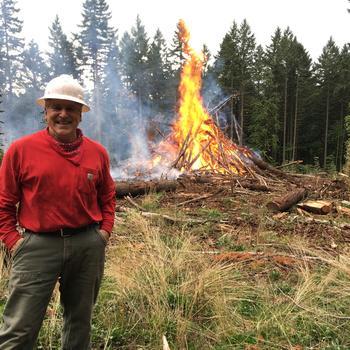Butterfly bush, Buddleja davidii, is a popular ornamental, but the species is very invasive throughout western Oregon. Note: A number of named cultivars are not considered invasive at this time.
Butterfly bush is a native of northwest China and Japan. It is drought tolerant and grows in a variety of soils and habitats, rapidly invading meadows, forest edges, dunes, and stream and river banks. It also invades disturbed sites such as forest areas after timber harvest, roadsides, and railroad rights-of-way. It can reach maturity in one year, forming dense thickets. Once established, butterfly bush outcompetes native vegetation.
Butterfly bush spreads by seed. Plants produce abundant seed, which spread by wind and water. Seeds can remain dormant for several years. When cut, butterfly bush will resprout. To remove or control it, both mechanical and chemical treatments are recommended.
Description
Butterfly bush is a deciduous to semievergreen shrub that grows up to 12 feet high and has a weeping form. Leaves are narrow (lance-shaped), opposite, and up to 4.5 inches long, green to blue-gray on top and white to silvery underneath. Flowers resemble a lilac’s: fragrant, showy, and purple.
Management options and prevention
Butterfly bush is difficult to control. If the infestation is only a few small plants, pulling and digging are effective. For larger plants, chemical control may be needed. If butterfly bushes are in riparian areas or near water, consult your local OSU Extension Service office, ODF stewardship forester or county weed control agent before you decide to use any chemicals. Some pesticides are restricted for use in or near waterways, to protect water quality and aquatic and riparian organisms.
Biological control
No biological control agents are available for butterfly bush in Oregon at this time.
Chemical control
Note: Before you apply herbicide on forest land, you must file a “notification of operations” with the Oregon Department of Forestry at least 15 days in advance. The following information about herbicides is only a brief summary; consult your local Extension agent or Oregon Department of Agriculture representative for specific recommendations for your situation. Read and follow the herbicide label carefully. Before spraying over or around tree seedlings, ensure the chemicals pose no hazard.
Cut-stump applications
Cut down the plant and treat the stump surface with triclopyr or glyphosate in late summer to early fall. Arsenal and Chopper (imazapyr) also work well as a foliage spray in spring or summer (be careful around tree seedlings). Note: Glyphosate is nonselective; that is, it will kill or injure any plant tissue it contacts, including that of desirable plants. However, triclopyr has some selectivity.
Hack-and-squirt
Hack around stem circumference with a hatchet and squirt Arsenal into the wound.
Foliar applications
Apply triclopyr to foliage in early to mid-summer. Or, apply glyphosate to foliage in late summer through early fall.
Basal applications
Apply 15% triclopyr ester in oil carrier to the lower 15 inches of the bush’s stems in early fall, soaking the bark to the ground line. Any herbicide treatment program should rotate among chemicals to prevent developing herbicide-resistant strains of the weed. For more detailed information on chemical control, refer to the PNW Weed Management Handbook and to Herbicide-resistant Weeds and Their Management, PNW 437.
Mechanical control
Hand pulling and digging are effective on small plants. Large shrubs are difficult to dig out, and, as noted earlier, cut stumps are likely to resprout. Grazing goats will eat butterfly bush. They strip and consume leaves and break plant branches. To be an effective control, grazing needs to be in a fenced area where animal pressure can be maintained for three to four years. It is not known how effectively grazing can eradicate butterfly bush in selected areas.
For more information
- Class B Noxious Weed List, Washington State Noxious Weed Control Board
- Oregon Department of Agriculture Oregon Noxious Weed Profiles
¡Use los pesticidas con seguridad!
- Póngase ropa de protección y equipo de seguridad según las recomendaciones de la etiqueta. Báñese después de cada uso.
- Lea la etiqueta del pesticida—aunque lo haya usado antes. Siga al pie de la letra las indicaciones de la etiqueta (y cualquiera otra indicación que Ud. tenga).
- Tenga precaución al aplicar los pesticidas. Conozca su responsabilidad legal como aplicador de pesticidas. Usted puede ser responsable de heridas o daños resultantes del uso de un pesticida.

